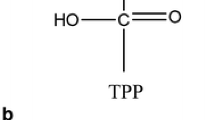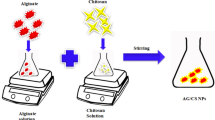Abstract
Alginate and chitosan nanoparticles were prepared using a new reverse micelle system, composed of cetyltrimethylammonium bromide (CTAB) as a surfactant, isooctane as a solvent, and 1-hexananol as a co-solvent. The obtained nanoparticles were characterized by FTIR, DLS and TEM techniques. The main objective of this study was to investigate the effects of polymer concentration, water content, and volumetric ratio of co-solvent to solvent on the physical and morphological properties of the prepared nanoparticles. To evaluate the results, the design of experimental was initially carried out and then the obtained data were statistically analyzed using the Qualitek-4® software. Results revealed that the size of the prepared alginate and chitosan nanoparticles varied in the range 220–490 and 210–1,050 nm, respectively. Furthermore, increasing either alginate or chitosan concentration increased the size of their nanoparticles. The results also showed that the size of nanoparticles was decreased with increasing the volumetric ratio of co-solvent/solvent. Finally, the size of alginate nanoparticles was increased by increasing the water content while it decreased the size of chitosan nanoparticles. Considering the statistical analysis of experiments, the polymer concentration is the major parameter affecting nanoparticles’ size. In contrast, water content has the smallest effect on the size of nanoparticles. However, the difference between the particle sizes of chitosan and alginate nanoparticles cab be attributed to the electrostatic repulsion between chitosan and CTAB.







Similar content being viewed by others
References
Yang H, Hua S, Wang W, Wang A (2011) Composite hydrogel beads based on chitosan and laponite: preparation, swelling, and drug release behaviour. Iran Polym J 20:479–490
Zhang N, Li J, Jiang W, Ren C, Li J, Xin J, Li K (2010) Effective protection and controlled release of insulin by cationic β-cyclodextrin polymers from alginate/chitosan nanoparticles. Int J Pharm 393:212–218
Dong Z, Wang Q, Du Y (2006) Alginate/gelatin blend films and their properties for drug controlled release. J Membr Sci 280:37–44
Finotelli PV, Morales MA, Rocha-Leão MH, Baggio-Saitovitch EM, Rossi AM (2004) Magnetic studies of iron(III) nanoparticles in alginate polymer for drug delivery applications. Mater Sci Eng C24:625–629
Du Y, Luo X-L, Xu J-J, Chen H-Y (2007) A simple method to fabricate a chitosan-gold nanoparticles film and its application in glucose biosensor. Bioelectrochemistry 70:342–347
Fan Q, Shan D, Xue H, He Y, Cosnier S (2007) Amperometric phenol biosensor based on laponite clay–chitosan nanocomposite matrix. Biosens Bioelectron 22:816–821
Kafshgari MH, Khorram M, Khodadoost M, Khavari S (2011) Reinforcement of chitosan nanoparticles obtained by an ionic cross-linking process. Iran Polym J 20:445–456
Murakami K, Aoki H, Nakamura S, Nakamura S-i, Takikawa M, Hanzawa M, Kishimoto S, Hattori H, Tanaka Y, Kiyosawa T, Sato Y, Ishihara M (2010) Hydrogel blends of chitin/chitosan, fucoidan and alginate as healing-impaired wound dressings. Biomaterials 31:83–90
Van der Lubben IV, Verhoef J, Borchard G, Junginger H (2001) Chitosan for mucosal vaccination. Adv Drug Deliv Rev 52:139–144
Sandford PA, Chitosan (1989) Commercial uses and potential applications. In: Skjåk-braek G, Anthonsen T, Sandford P (eds) Chitin and chitosan. Elsevier Applied Science, New York, pp 51–69
Trimukhe K, Varma A (2008) A morphological study of heavy metal complexes of chitosan and crosslinked chitosans by SEM and WAXRD. Carbohydr Polym 71:698–702
Monier M, Ayad DM, Wei Y, Sarhan AA (2010) Immobilization of horseradish peroxidase on modified chitosan beads. Int J Biol Macromol 46:324–330
Zohuriaan-Mehr MJ (2005) Advances in chitin and chitosan modification through graft copolymerization: a comprehensive review. Iran Polym J 14:235–265
Qi L, Xu Z, Jiang X, Hu C, Zou X (2004) Preparation and antibacterial activity of chitosan nanoparticles. Carbohydr Res 339:2693–2700
Sarmento B, Ferreira D, Veiga F, Ribeiro A (2006) Characterization of insulin-loaded alginate nanoparticles produced by ionotropic pre-gelation through DSC and FTIR studies. Carbohydr Polym 66:1–7
Gan Q, Wang T (2007) Chitosan nanoparticle as protein delivery carrier—systematic examination of fabrication conditions for efficient loading and release. Colloid Surf B 59:24–34
Fang Y, Bennett A, Liu J (2010) Multiply charged gas-phase NaAOT reverse micelles: formation, encapsulation of glycine, and collision-induced dissociation. Int J Mass Spectrom 293:12–22
Osfouri S, Stano P, Luisi PL (2005) Condensed DNA in lipid microcompartments. J Phys Chem B 109:19929–19935
Bodnar M, Hartmann JF, Borbely J (2005) Preparation and characterization of chitosan based nanoparticles. Biomacromolecules 6:1397–1399
Mitra S, Gaur U, Ghosh PC, Maitra AN (2001) Tumour targeted delivery of encapsulated dextran–doxorubicin conjugate using chitosan nanoparticles as carrier. J Control Rel 74:317–323
De Moura MR, Aouada FA, Mattoso LH (2008) Preparation of chitosan nanoparticles using methacrylic acid. J Colloid Interface Sci 321:477–483
Zhi J, Wang Y, Lu Y, Ma J, Luo G (2006) In situ preparation of magnetic chitosan/Fe3O4 composite nanoparticles in tiny pools of water-in-oil microemulsion. React Funct Polym 66:1552–1558
Zhi J, Wang Y, Luo G (2005) Adsorption of diuretic furosemide onto chitosan nanoparticles prepared with a water-in-oil nanoemulsion system. React Funct Polym 65:249–257
Zhou L, Xu J, Liang X, Liu Z (2010) Adsorption of platinum(IV) and palladium(II) from aqueous solution by magnetic cross-linking chitosan nanoparticles modified with ethylenediamine. J Hazard Mater 182:518–524
Liu G, Shao L, Ge F, Chen J (2007) Preparation of ultrafine chitosan particles by reverse microemulsion. Particuology 5:384–390
Pongjanyakul T, Rongthong T (2010) Enhanced entrapment efficiency and modulated drug release of alginate beads loaded with drug–clay intercalated complexes as microreservoirs. Carbohydr Polym 81:409–419
Yuan Q, Shah J, Hein S, Misra R (2010) Controlled and extended drug release behavior of chitosan-based nanoparticle carrier. Acta Biomater 6:1140–1148
Mathew DS, Juang RS (2007) Role of alcohols in the formation of inverse microemulsions and back extraction of proteins/enzymes in a reverse micellar system. Sep Purif Technol 53:199–215
Zhang T, Liu H, Chen J (1999) Affinity extraction of BSA with reversed micellar system composed of unbound Cibacron blue. Biotechnol Progr 15:1078–1082
Debuigne F, Jeunieau L, Wiame M, Nagy JB (2000) Synthesis of organic nanoparticles in different W/O microemulsions. Langmuir 16:7605–7611
Hingorani S, Pillai V, Kumar P, Multani MS, Shah DO (1993) Microemulsion mediated synthesis of zinc-oxide nanoparticles for varistor studies. Mater Res Bull 28:1303–1308
Husein M, Rodil E, Vera JH (2005) A novel method for the preparation of silver chloride nanoparticles starting from their solid powder using microemulsions. J Colloid Interf Sci 288:457–467
Husein M, Rodil E, Vera JH (2006) A novel approach for the preparation of AgBr nanoparticles from their bulk solid precursor using CTAB microemulsions. Langmuir 22:2264–2272
Lopez-Quintela MA, Rivas J (1993) Chemical reactions in microemulsions: a powerful method to obtain ultrafine particles. J Colloid Interf Sci 158:446–451
Nassar N, Husein M (2006) Preparation of iron oxide nanoparticles from FeCl3 solid powder using microemulsions. Phys Status Solid A 203:1324–1328
Palla BJ, Shah DO, Garcia-Casillas P, Matutes-Aquino J (1999) Preparation of nanoparticles of barium ferrite from precipitation in microemulsion. J Nanopart Res 1:215–221
Pillai V, Kumar P, Hou M, Ayyub P, Shah D (1995) Preparation of nanoparticles of silver halides, superconductors and magnetic materials using water-in-oil microemulsions as nano-reactors. Adv Colloid Interf Sci 55:241–269
Kuboi R, Mori Y, Komasawa I (1990) Reverse micelle size distribution and mechanism of protein solubilization into reverse micelles. Kagaku Kogaku Ronbunshu 16:763–771 (in Japanese)
Kiyoyama S, Shiomori K, Kawano Y, Yoshizawa H, Yoshida M, Hatate Y (2005) Characteristics of nano-capsules prepared using reserve micellar system. Chem Eng Res Des 83:861–865
Jiang X, Chen L, Zhong W (2003) A new linear potentiometric titration method for the determination of deacetylation degree of chitosan. Carbohydr Polym 54:457–463
Author information
Authors and Affiliations
Corresponding author
Rights and permissions
About this article
Cite this article
Kafshgari, M.H., Khorram, M., Mansouri, M. et al. Preparation of alginate and chitosan nanoparticles using a new reverse micellar system. Iran Polym J 21, 99–107 (2012). https://doi.org/10.1007/s13726-011-0010-1
Received:
Accepted:
Published:
Issue Date:
DOI: https://doi.org/10.1007/s13726-011-0010-1




